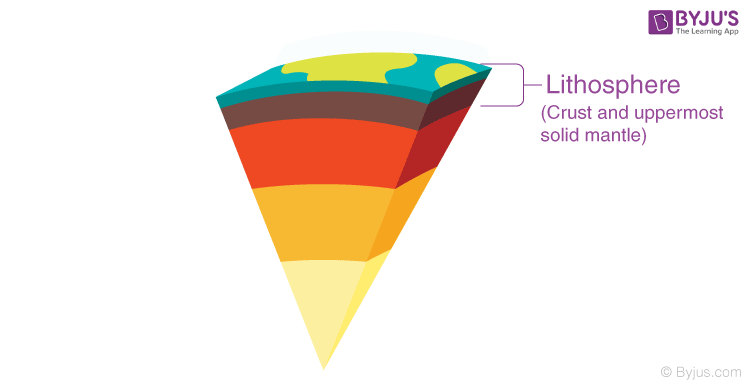The lithosphere is the outermost layer of the Earth. In this article, let us understand its definition, composition and different types of the lithosphere.
| Table of Contents |
What is Lithosphere?
The lithosphere is the rigid, outermost shell on Earth. It is composed of the crust and the portion of the upper mantle that behaves elastically on time scales of thousands of years or greater. The outermost shell of a rocky planet, the crust, is defined on the basis of its chemistry and mineralogy.

This includes the crust and the uppermost mantle, which constitute the hard and rigid outer layer of the Earth. The uppermost part of the lithosphere that chemically reacts to the atmosphere, hydrosphere, and biosphere through the soil-forming process is called the pedosphere.
The video explains the layers of the Earth

Lithosphere Composition
The earth’s crust is not a homogeneous substance; it has different layers of rocks including sedimentary rocks on top, granitic and metamorphic rocks in the middle, and basaltic rocks on the bottom.
The earth’s crust also consists of several large dynamic tectonic plates. These tectonic plates move slowly but continuously at an average rate of around 10 cm. Considering this, there was no Atlantic Ocean, and North America and Europe together were one continent 180 million years ago. The Atlantic Ocean came into being because of the drifting apart from the Eurasian and North American plates.
Types of Lithosphere
There are two types of lithosphere:
- Oceanic: Which is associated with oceanic crust and exists in the ocean basins.
- Continental: This is associated with continental crust.
Frequently Asked Questions – FAQs
What is Lithosphere?
Why is Lithosphere important?
What are the different types of Lithosphere?
i) Oceanic
ii) Continental
What is Pedosphere?
What is the composition of Earth’s crust?
Stay tuned with BYJU’S for more such interesting articles. Also, register to “BYJU’S – The Learning App” for loads of interactive, engaging Physics-related videos and unlimited academic assistance.

Comments